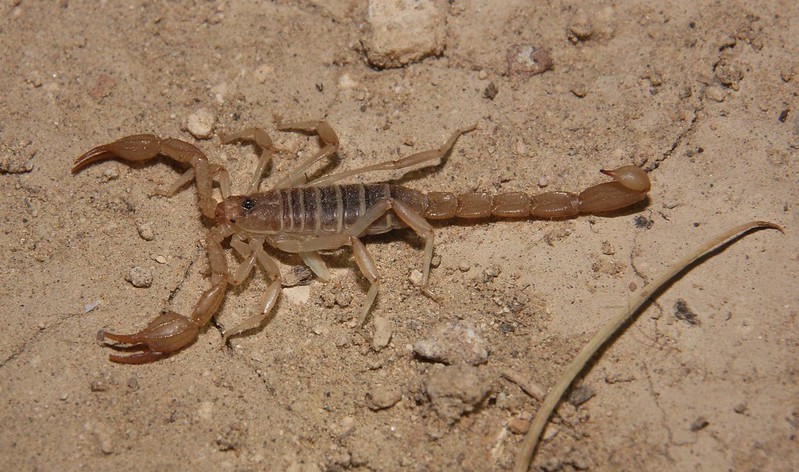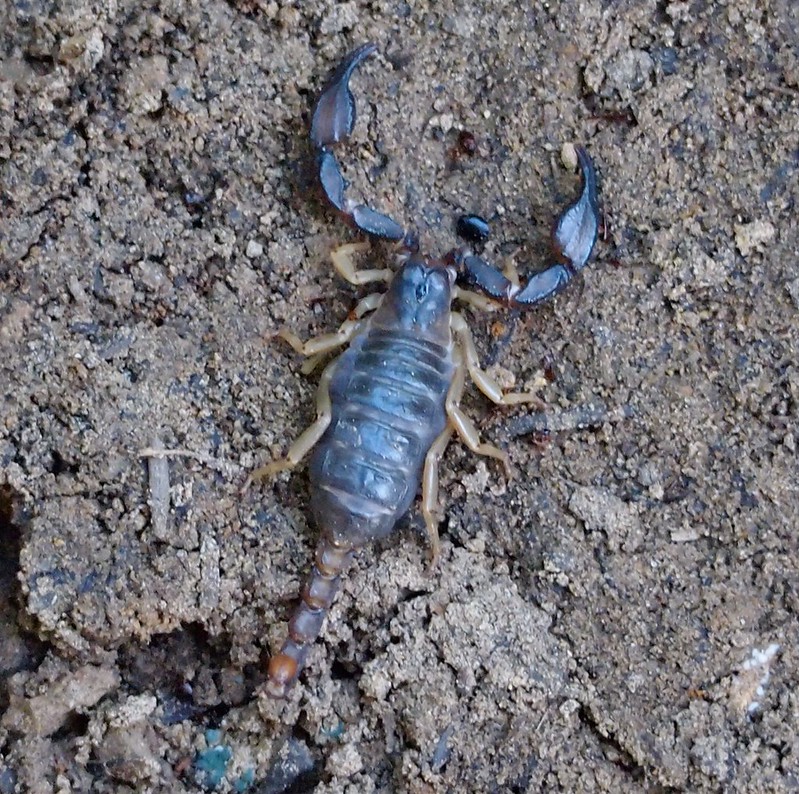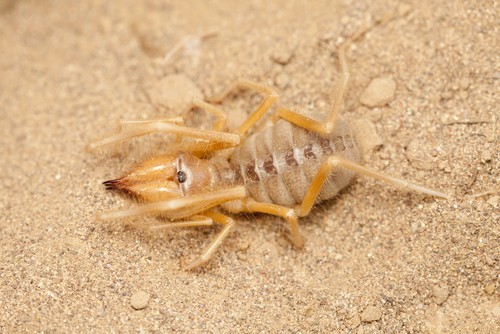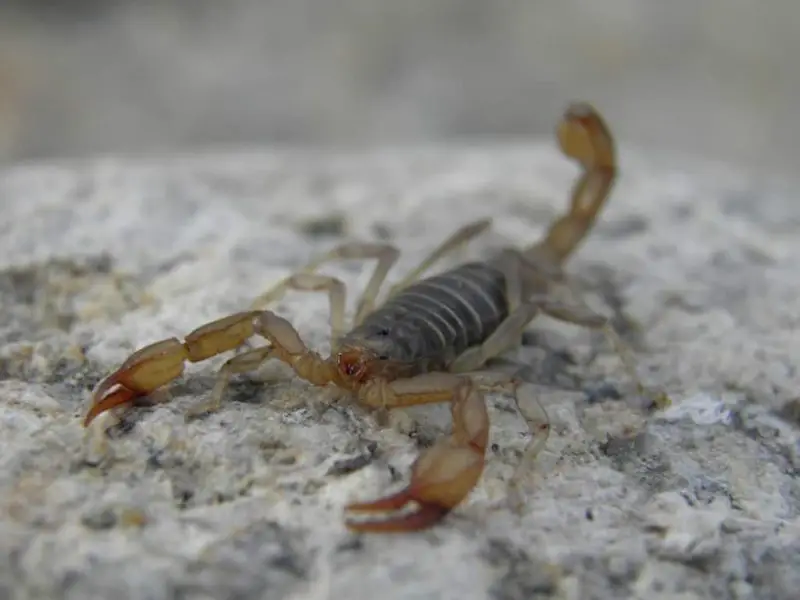When Americans think of scorpions, they think of the desert southwest. However, the state of Washington is home to two species of scorpions. These are the Northern Scorpion (Paruroctonus boreus) and the Northwest Forest Scorpion (Uroctonus mordax).
There are 70 or so types of scorpions in North America. Of these, only the Arizona bark scorpion (Centruroides sculpturatus), has a sting that is potentially deadly. See
Neither the northern scorpion nor the Northwest Forest scorpion has a sting that is any more medically significant than a bee sting. However, all stings have the potential to cause a severe allergic reaction.
There are also two scorpion-like arachnid species that call the evergreen state home. These are the pseudoscorpion and the wind scorpion.
We’ll go into more detail about the state of Washington’s Northern scorpions, Northwest forest scorpions, pseudoscorpions, and wind scorpions in the paragraphs below.

The Northern Scorpion (Paruroctonus boreus)
Also see:
Scorpions in North Dakota – Krebs Creek
Scorpions in Montana – Krebs Creek
Scorpions in Wyoming – Krebs Creek
Scorpions in Alberta – Krebs Creek
The northern scorpion or boreal scorpion is a species of scorpion in the family Vaejovidae.
Northern scorpions are found in 12 U.S. states and 3 Canadian provinces. The northern scorpion species’ range begins in northern Arizona and goes north to southwestern Canada. In the United States, northern scorpions live in Arizona, California, Nevada, Utah, Idaho, Wyoming, Montana, North Dakota, South Dakota, Oregon, and Washington. In Canada, Northern Scorpions live in southern British Columbia, southern Alberta, and southern Saskatchewan. See
In Washington, northern scorpions live almost entirely east of the cascades.
Northern scorpions are the most northern species of scorpion due to their ability to tolerate some cold. In fact, they are the only species of scorpion to live in Canada.
What do northern scorpions look like?
Scorpions look a little bit like tiny land-dwelling lobsters with some distinctions. Lobsters have 10 legs, while scorpions have 8, and of course, lobsters don’t have bulbous venom-filled stingers on the end of their tail, while scorpions do.
Northern scorpions have segmented sections in their exoskeletons that range in color from light brown to dark brown. What’s more, they have a yellowish-colored, proportionately thin, long tail with a stinger on the tip and two lobster-like front pinchers or pedipalps that do not function as legs. Instead, they use their pedipalps to capture and hold their prey.
Northern scorpions are relatively small scorpions. An adult northern scorpion will be 35mm to 55mm (1.37 to 2.16 inches) long. Northern scorpions display sexual dimorphism, with females being consistently larger than males. See
Northern scorpions are nocturnal creatures, meaning that they come out and are active at night. Inversely, they are mostly inactive during the day.
As most scorpions do, they have fluorescent compounds in their exoskeletons that make them glow under ultraviolet light. If you are camping in an area where northern scorpions are active, it’s a good idea to go armed with an ultraviolet flashlight. Use the UV light to scan your campsite after dark, after 9:30 PM to be exact.
Although the venomous sting from a northern scorpion generally isn’t very dangerous, it still wouldn’t do to share your sleeping bag with one. Like all scorpions, northern scorpions are nocturnal hunters. As such, they will be out and about after dark, searching for small prey such as grasshopper nymphs.
Northern Scorpion Behavior
Like most scorpions, northern scorpions are nocturnal. In fact, they are most active between 9:30 PM and 11:00 PM. If they have not come out of their burrows by 11:00 PM, it is unlikely that they will immerge to feed that night. Additionally, they will not come out of their burrows to hunt during a rainstorm and are much less active for 3 to 5 days after a rainstorm.
The Northern scorpion is a burrowing scorpion. As such, they are similar to other North American burrowing scorpions, such as the Northern Desert Hairy Scorpion, in that they seldom venture more than a dozen feet from their lairs to hunt. In the fall season, it’s not uncommon for them to move inside some manmade structure to live out the months of cold weather. However, they usually hibernate through the winter months in their underground burrows.
The percentage of the time that northern scorpions utilize their venom to subdue their prey falls dramatically with the age of the scorpion. Northern scorpions that are less than 2 months old use their stingers each time they subdue prey. On the other hand, adults which have more strength in their pedipalps only use their stingers around 30% of the time. The other 70% of the time, they opt to subdue their prey using only their pedipalps to grasp it until it ceases to struggle. See
Northern scorpions are born alive. When the female gives birth, she assumes a sitting position on her hind legs. She will give birth to 10 to 40 young.
After the newborn northern scorpions free themselves from the birth membrane, they will climb up their mother’s walking legs and onto her back. They will ride there in a grouped formation, only climbing down to feed on pellets that their mother creates for them when she feeds until they are sufficiently old to strike out on their own. See
Are Northern Scorpions Dangerous?
Unlike the Arizona Bark scorpion, for example, which is the most venomous scorpion in North America, Northern scorpions are not particularly dangerous to humans.
Northern scorpions seldom sting humans. They reserve their venom to subdue their prey animals which include small insects and arachnids. What’s more, the sting from a northern scorpion is no more dangerous than a wasp sting. However, all scorpion stings carry the possibility of severe allergic reactions. If you or someone you know experiences slurred speech or difficulty breathing after being stung by a scorpion, seek immediate medical attention.

Northwest Forest Scorpion (Uroctonus mordax)
The Northwest Forest scorpion goes by more than one common name. They’re also called the Western Forest scorpion, the Pacific Forest scorpion, or California Forest scorpion.
In appearance, northwest forest scorpions are around 2 inches long. Their bodies are either black or dark brown, while their legs are semitransparent yellowish brown. Their tails are proportionately long and thin compared to other scorpion species. On the other hand, their claws are proportionately large.
These scorpions live for around 10 years in the wild.
In Washington, Northwest Forest scorpions live primarily in the Cascade foothills on the west side of that mountain range. They also exist in both the Oregon and Washington sides of the Columbia River gorge.
This little scorpion requires moister environments than most scorpion species. Look for them on heavily forested, west-facing slopes. Their hiding places include leaf litter, the space underneath flat rocks and logs, and the crevasses between talus rocks.
Although they have the ability to sting you, these scorpions will usually either play dead or hide rather than sting defensively unless, of course, they’re trapped against your skin, like, for instance, in a shoe.
Like most scorpions, northwest forest scorpions’ exoskeletons glow under black light. They are nocturnal hunters and are even less likely to be out hunting when there is excessive moonlight. If you want to find one, you may need to try looking with a UV flashlight on a moonless night.

Wind Scorpions in Washington State
Another interesting arachnid that you might run across in the evergreen state is the wind scorpion. Wind scorpions are also sometimes called sun spiders or camel spiders. In fact, they are a smaller cousin to the giant camel spiders found in the middle east.
These creatures have strong jaws that are capable of delivering a painful bite. However, they are not venomous. These arachnids are noted for their aggressive behavior, whether it be in hunting or self-defense.
They look like a cross between a spider and a scorpion, but they are actually neither. They are an arachnid, but they are from the order sollifugae. Sollifugae are unique among arachnids in that they have 10 legs rather than 8. They use their front pair of legs in concert with their sense of sight to feel out the route in front of them. There are more than 1000 sollifugae species that live in Asia, Africa, the Americas, and southern Europe. See
In North America, most wind scorpion species are nocturnal. They spend the daylight hours in shallow burrows, under rocks, wood debris, or dried cattle dung. They are extremely quick, aggressive predators that feed on anything they can catch. This includes insects, other arachnids, or animals that are several times their size, such as small lizards and small rodents. See

Pseudoscorpions in Washington State
The pseudoscorpion is a tiny arachnid that looks a lot like a tiny scorpion minus the stinger. These little guys have a flat, pear-shaped body, eight legs, and two long pedipalps with pinchers on the ends, just like scorpions.
Some other common names for the pseudoscorpion are false scorpion or book scorpion.
People also sometimes mistake these tiny little creatures for ticks. There are over 3,300 pseudoscorpion species worldwide, and their average body length is just 3 millimeters.
Book scorpions don’t have a stinger on their tail. However, they do have a stinger in each pincher. They inject their prey with venom to immobilize it. After which, they secrete a fluid over it to dissolve it so that they can ingest the liquified remains.
Book scorpions are generally beneficial to humans since they prey on pests such as clothes moth larvae, carpet beetle larvae, booklice, ants, mites, and small flies. See
Recent Posts
The only venomous snakes in Washington State are Northern Pacific Rattlesnakes. The Northern Pacific Rattlesnake (Crotalus oreganus oreganus) is a sub-species of the Western Rattlesnake. Anyone...
Skunks are not classified as true hibernators. But they go into a state of torpor when the weather gets cold. Skunks are light sleep hibernators, along with opossums, bears, and raccoons. ...

